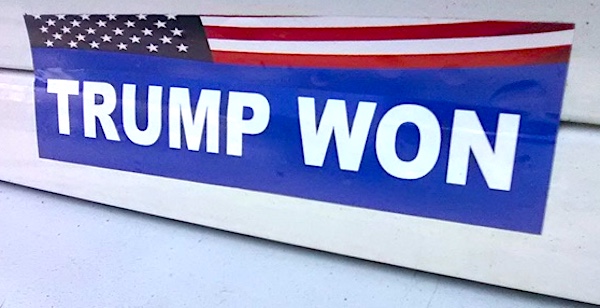
By making accusations of vote fraud he was not able to prove, both before and after the election, Donald Trump made it easy for his critics to dismiss as dishonest any and all concerns about election integrity. Typical was a New York Times “fact check” from late September denouncing as “false” GOP claims that expanding access to absentee ballots and voting by mail facilitated election fraud.
“There have been numerous independent studies and government reviews finding voter fraud extremely rare in all forms,” wrote Linda Qiu. That includes “‘absentee ballots’ and ‘vote-by-mail ballots’” between which there is “no meaningful difference.” Not only are both “secure forms of voting,” according to Qiu; they are considered the “gold standard of election security.”
To pass a law limiting the use of absentee ballots, as Georgia recently did, is no longer to choose a side in a legitimate debate over how to balance ballot integrity and ease of voting. Instead, to express concern about the risk of election fraud is seen as being engaged in a different sort of fraud — an illegitimate effort to disenfranchise the poor and minorities. The New York Times has aggressively insisted the last several months that worries over absentee and mail-in ballots, in particular, are dishonest violations of voting rights. Times staff opinion editor Spencer Bokat-Lindell wrote late in October that “[t]he effort to discredit and discourage mail-in voting” was the “culmination of a decades-long disinformation campaign by the Republican Party and others to suppress votes, especially those cast by Black and Latino Americans.”
But what of the Times itself, which for over two decades has warned readers that the most common sort of election fraud involves absentee voting? As recently as September, Times reporters Stephanie Saul and Reid Epstein quoted Richard Hasen, who teaches election law at the University of California, Irvine, saying that “[e]lection fraud in the United States is very rare, but the most common type of such fraud in the United States involves absentee ballots.”
In 2018 operatives working for the Republican candidate for North Carolina’s Ninth Congressional District seat, falsified absentee ballots. Times reporters Alan Blinder and Michael Wines told readers that the state’s long history of election fraud was “under a spotlight.” They quoted lawyer Bill Gilkeson saying that “absentee ballots” were “where the fraud really happens.” In 2019 Blinder wrote, “The Ninth District controversy ranks among the highest-profile examples of modern election fraud,” one that “underscores how absentee ballots remain susceptible to abuse.”
What accounts for the change from a dark presentation of the issue to a decidedly rosy one? RealClearInvestigations asked a spokesperson for the New York Times whether the paper’s current enthusiasm for absentee voting meant its staff’s previous criticism and reporting were wrong or misleading. RCI also asked whether the articles had been, even just unintentionally, part of what Times staff editor Bokat-Lindell called “a decades-long disinformation campaign by the Republican Party and others to suppress votes”? She did not respond to those two questions.
But the examples already cited here do not seem to be outliers. The headline of a 2012 article by Times legal affairs reporter Adam Liptak shouted, “Error and Fraud at Issue as Absentee Voting Rises.” Liptak declared that liberalized absentee voting “increases the potential for fraud.”
So grave are “the flaws of absentee voting,” according to the Times, that they “raise questions about the most elementary promises of democracy.” Under a section heading “Fraud Easier Via Mail,” Liptak wrote: “Election administrators have a shorthand name for a central weakness of voting by mail. They call it granny farming.” We learned from the Times that campaign operatives “helped” voters in nursing homes. Such voters “can be subjected to subtle pressure, outright intimidation or fraud. The secrecy of their voting is easily compromised. And their ballots can be intercepted both coming and going.”
“Absentee ballots also make it much easier to buy and sell votes,” Liptak continued. “In recent years, courts have invalidated mayoral elections in Illinois and Indiana because of fraudulent absentee ballots.” It would be hard to pull off some types of election fraud, he wrote. Impersonate voters on a scale large enough to be likely to affect the outcome of an election, and you’re likely to be caught. The Times quoted no less an authority than Heather Gerken, an elections expert who is now dean of Yale Law School, on where to find fraud: “You could steal some absentee ballots or stuff a ballot box or bribe an election administrator or fiddle with an electronic voting machine,” Gerken told Liptak, concluding that is “why all the evidence of stolen elections involves absentee ballots and the like.” RealClearInvestigations reached out to Gerken asking whether she stood by her comments. She did not respond.
The Liptak article, with its central thesis that “mailed ballots” are “more likely to be compromised and contested than those cast in person,” was persuasive enough that Supreme Court Justice Clarence Thomas quoted from it in a recent dissent.
Also in 2012, The New York Times published an op-ed by Hasen, the professor at UC Irvine whom Times reporters quoted just this past September. In the op-ed he observed, “Every year we see convictions for absentee ballot fraud. Not a lot, but enough to know it’s a problem.” Hasen wrote he had found no election in decades “in which impersonation fraud had the slightest chance of changing an election outcome.” But absentee-ballot fraud is a different matter altogether. Hasen wrote it “changes election outcomes regularly.”
Contacted by RealClearInvestigations, Hasen stands by his observations. He says that in the last decade, the “ability to conduct absentee voting has improved,” but that “anytime ballots are outside the control of election officials, there’s risk.” He suggests that the difference in statements about absentee ballots made in the New York Times may be explained by some assertions being made by news reporters and other claims by the opinion staff of the paper.
In 2011, Pulitzer Prize-winning Timesman Charlie Savage wrote that, compared with in-person voting, there was “greater evidence that absentee ballot fraud has been used to attempt to alter the results of an election.”
Joyce Purnick penned a page-one story in the New York Times in September 2006 declaring, “Experts in election law say most voter fraud involves absentee balloting.” In 2004, the paper warned of fraud in the upcoming national election: Officials “are struggling to cope with coercive tactics and fraudulent vote-gathering involving absentee ballots that have undermined local races across the country,” wrote reporter Michael Moss. The Times worried that many states had “abandoned or declined to adopt the safeguards on absentee voting that election officials have warned they will need to prevent rigged elections.”
In November 2000, the New York Times’s Leslie Wayne warned about the expansion of absentee voting: “The alternatives to traditional voting are more susceptible to fraud.” Wayne attributed the concern to “experts” who said that “[a]bsentee ballots can be more easily sold or shown to others before they are cast.”
The New York Times now insists through its designated arbiter of verified facts that absentee voting is the “gold standard”; the opinion page denounces any concern about the practice as not just wrong, but a myth used to suppress voting by the poor and minorities. And yet for more than 20 years the Times has been making the not-unreasonable case that absentee ballots are more susceptible to fraud than in-person voting.
One might ask whether the Times, in its eagerness to discredit arguments with which it now disagrees, has thrown decades of its own reporting under the bus.
That’s effectively the question put to the Times, but not answered.


